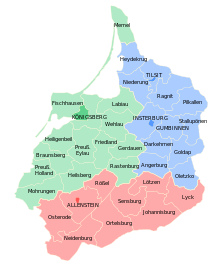This article needs additional citations for verification .(March 2021) |

The Goldap district was a Prussian district in East Prussia that existed from 1818 to 1945. Its territory is now divided between the Polish Warmian-Masurian Voivodeship and the Russian Kaliningrad Oblast. 54°18′58″N22°18′34″E / 54.31611°N 22.30944°E
Contents
- History
- Kingdom of Prussia
- Germany
- Demographics
- Politics
- District Administrators
- Elections
- Municipalities
- Municipalities dissolved before 1945
- Place Names
- References
